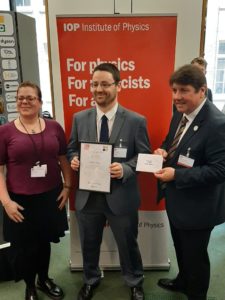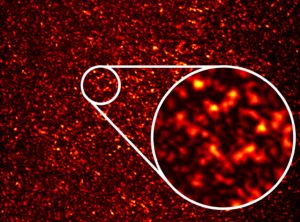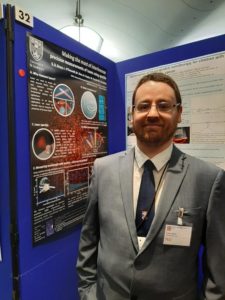Silver success for Graham at STEM for Britain 2020
 At this year’s STEM for Britain competition in the UK Houses of Parliament, our Senior Research Laboratory Manager, Dr Graham Bruce, won the Silver award for the excellence of his physics research. Graham presented his research into the use of speckle for laser wavelength measurement to dozens of politicians and a panel of expert judges, on Monday 9th March.
At this year’s STEM for Britain competition in the UK Houses of Parliament, our Senior Research Laboratory Manager, Dr Graham Bruce, won the Silver award for the excellence of his physics research. Graham presented his research into the use of speckle for laser wavelength measurement to dozens of politicians and a panel of expert judges, on Monday 9th March.
Since their invention 60 years ago, lasers have revolutionised the way we measure the world. For example, they allow us to measure the precise chemical composition of unknown substances, and keep track of time to the incredible accuracies needed to allow GPS satellite navigation to work. Importantly, in all these applications we need an accurate way to measure the properties of the laser itself, which is in fact not as simple as it sounds!
In recent work, Graham and his colleagues in the Optical Manipulation Group have pioneered a new approach to measure laser wavelength with remarkable precision. Their approach starts with a surprising step: to measure a laser beam precisely, they first convert the beam into the biggest mess possible by shining the laser light at a rough surface, which could be something as simple as Sellotape or white paint, to scatter the light. This creates a grainy pattern, through the process of interference of the scattered light, known as speckle. This pattern is most familiar as the white noise which used to be seen on analogue televisions in bad weather, and is usually seen as an obstacle to any laser-based application as it seems random and uncontrolled. However, the pattern itself is very rich in information.
 The exact speckle pattern produced is very sensitive to changes of the properties of the light, such as wavelength. Powerful numerical techniques can then be used to extract the wavelength from an individual speckle pattern. The speckle wavemeter can measure the wavelength of individual laser beams to attometre precision. For context, this is equivalent to measuring the distance around the Earth’s equator to an accuracy of the thickness of a human hair! The accuracy is a thousand-fold improvement on state-of-the-art commercial wavelength meters, and can be realised in a robust, compact and low-cost device.
The exact speckle pattern produced is very sensitive to changes of the properties of the light, such as wavelength. Powerful numerical techniques can then be used to extract the wavelength from an individual speckle pattern. The speckle wavemeter can measure the wavelength of individual laser beams to attometre precision. For context, this is equivalent to measuring the distance around the Earth’s equator to an accuracy of the thickness of a human hair! The accuracy is a thousand-fold improvement on state-of-the-art commercial wavelength meters, and can be realised in a robust, compact and low-cost device.
We have also shown that the approach can independently measure the wavelength of multiple lasers simultaneously. These advances promise a step change for the information-carrying capacity of optical fibres, in chemical sensing and in the development of portable quantum technologies.
Graham was judged against 23 other shortlisted physicists, in a competition that also includes categories for researchers who are chemists, biologists, engineers and mathematicians, and is the only one of its kind, taking place in Parliament itself.
The Parliamentary and Scientific Committee runs the event in collaboration with the Council for the Mathematical Sciences, the Institute of Physics, Physiological Society, the Nutrition Society, Royal Academy of Engineering, the Royal Society of Biology and the Royal Society of Chemistry. There are only three winners in each category though, and Graham’s Silver medal is a fantastic achievement.
Find out more:
- Graham’s Poster from the event
- FEMTOMETER-RESOLVED SIMULTANEOUS MEASUREMENT OF MULTIPLE LASER WAVELENGTHS IN A SPECKLE WAVEMETER
G. D. Bruce, L. O’Donnell, M. Chen, M. Facchin and K. Dholakia, arXiv: 1910.13411, accepted in Opt. Lett. - DEEP LEARNING ENABLED LASER SPECKLE WAVEMETER WITH A HIGH DYNAMIC RANGE
R. K. Gupta, G. D. Bruce, S. J. Powis and K. Dholakia, arXiv: 1910.10702 - HIGH SPEED DETERMINATION OF LASER WAVELENGTH USING POINCARÉ DESCRIPTORS OF SPECKLE
L. O’Donnell, K. Dholakia and G. D. Bruce, Opt. Commun. 459, 124906 (2020) / arXiv: 1908.00665 - OVERCOMING THE SPECKLE CORRELATION LIMIT TO ACHIEVE A FIBER WAVEMETER WITH ATTOMETER RESOLUTION
G. D. Bruce, L . O’Donnell, M. Chen and K. Dholakia, Opt. Lett. 44, 1367 (2019) - HARNESSING SPECKLE FOR A SUB-FEMTOMETRE RESOLVED BROADBAND WAVEMETER AND LASER STABILIZATION
N. K. Metzger, R. Spesyvtsev, G. D. Bruce, B. Miller, G. T. Maker, G. Malcolm, M. Mazilu and K. Dholakia, Nat. Commun. 8, 15610 (2017)
